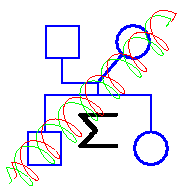
1. (based on Lange Ch 5 #3)
A brother-sister full-sib pair, A and B,
(mice, not humans) produce two offspring,
D and E.
(The kinship coefficient of full sibs is 1/4.)
(a) What is the inbreeding coefficient of D ?
(b) What is the kinship coefficient between D and B ?
(c) What is the kinship coefficient between D and E ?
(d) What is the probability D and E carry 4 IBD genes at a locus ?
(e) What is the probability D and E each carries two IBD genes at a locus,
but these are different genes?
(For (d) and (e), it is easiest to just draw a picture and count the ways.)
Answers (?): 1/4, 3/8, 3/8, 1/16, 1/32
2. Using the Cleopatra pedigree:
(a) Find the inbreeding coefficient of Cleopatra III of Egypt.
(b) Find the kinship coefficient of Ptolemy VIII Physcon and
Cleopatra III of Egypt.
(Note this is the inbreeding coefficient of each of their four childen.)
(c) Find the inbreeding coefficient of Berenice III of Egypt.
(d) Find the inbreeding coefficient of Cleopatra VII.
Probably the easiest way to do this is top-down, filling in relevant terms
of the pairwise kinship matrix.
Remember the diagonal terms are the kinship
of an individual with itself (i.e. (1+f)/2)
You may write R-code, or run a kinship computation software if you wish,
but should explain the numerical results you obtain.
Answers (??? fixed): 1/4, 1/4, 13/32, 0.43359 (?? from computer) -- which appears to be 111/256.
3. (Based on Lange Ch 6, #1, and an example of Cavalli-Sforza and Bodmer)
In an idealized infinite population, 10% of people marry their first cousins
(kinship coefficient 1/16), 25% marry their second cousins (kinship coefficient
1/64), and the remaining 65% marry unrelated individuals. All marriages have
the same family size distribution. Consider a very rare recessive trait,
with allele frequency q.
(a) Show that the mean inbreeding coefficient in the population is just over
1%.
(b) Show that the overall probability an individual is affected is
q(0.01 + 0.99q)
(c) Show that the probability an affected individual is the child of a
first-cousin marriage is 0.00625(1+15q)/(0.01 + 0.99q).
(d) How small must q be in order that the posterior probability an affected
individual is the child of a first-cousin marriage is larger than the posterior
probability the child is from a second-cousin marriage. (Answer (?): 0.015.)
4. (based on Crow and Kimura, Ch 4, #9)
This makes exact the notion due to Wright that gene identity by
descent leads to correlations between relatives.
Consider a particular allele A with allele frequency q, and define
indicator random variables I(g), for a gene g, where I(g)=1
if the allelic type of gene g is A, and 0 otherwise.
(a) Show E(I(g)) = q, and var(I(g)) = q(1-q)
(b) Show that for genes g1 and g2 segregating from B and from C,
the correlation between I(g1) and I(g2)) is the kinship
coefficient between B and C.
(c) If g1 and g2 are the two genes in an individual, shown that
the variance of (I(g1)+I(g2)) is 2q(1-q)(1+f), where f is the
inbreeding coefficient of the individual.
(d) If g1 and g2 are the genes in a parent B, and g2 and g3 are the
genes in his child C (that is, the g2 gene is the one inherited
by C from B), show that the correlation between (I(g1)+I(g2)) and
(I(g2)+I(g3)) is
(1+2fC+fB)/(2((1+fC)(1+fB))1/2)
where fB is the inbreeding coefficient of B, and fC
is the inbreeding coefficient of C.